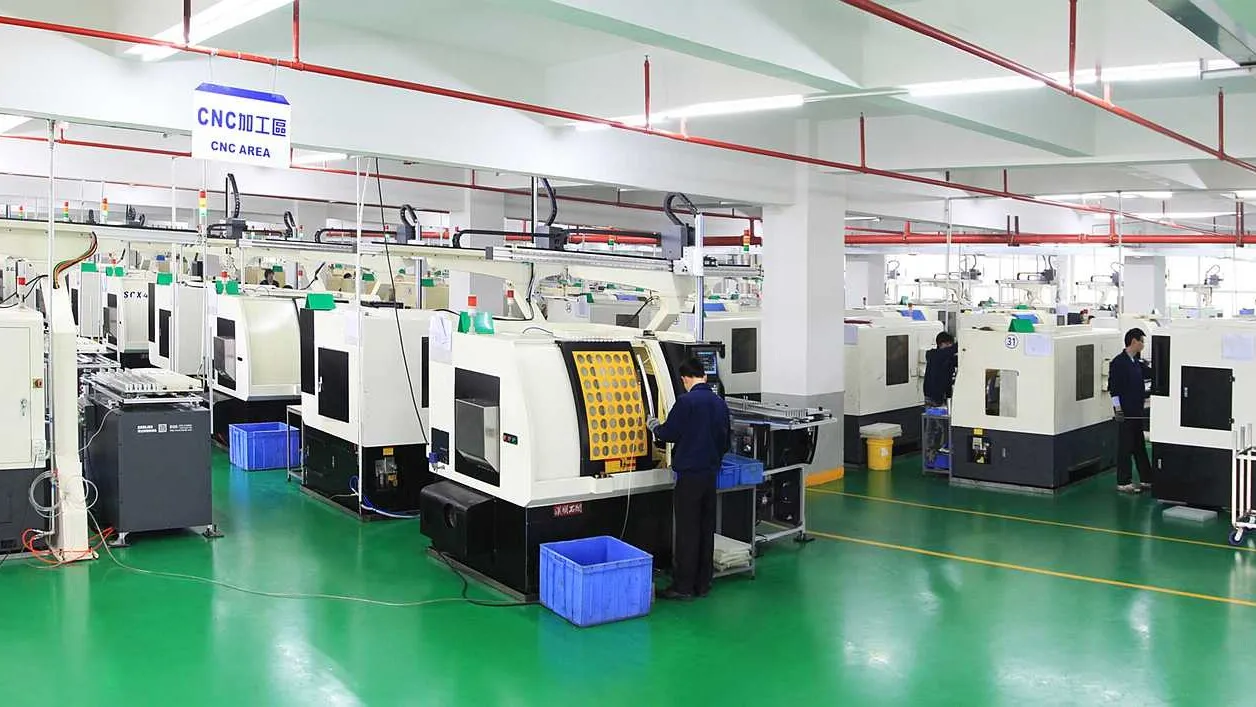A CNC machining factory represents a highly organized production environment where computer-controlled machine tools transform raw materials into precision components. The facility typically houses multiple CNC machining centers, including milling machines, lathes, grinders, and EDM equipment, arranged in logical workflow patterns to optimize material handling and production efficiency. The factory floor maintains controlled environmental conditions, with temperature and humidity stabilization systems ensuring consistent machining accuracy across all workstations. Overhead cranes and forklift pathways enable movement of heavy workpieces between machines, while centralized chip collection systems manage the byproducts of high-volume production. The physical layout follows lean manufacturing principles, minimizing unnecessary part movement and creating efficient cells for similar machining processes.
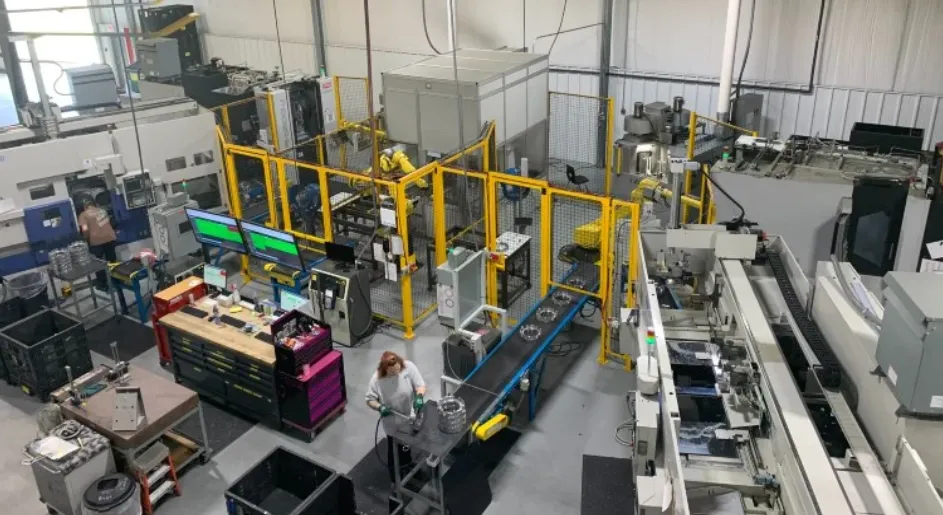 Material storage and preparation areas form a critical part of the factory’s workflow. Raw material arrives as precision-ground stock in various forms – aluminum and steel billets, brass rods, plastic sheets, and specialty alloys – all carefully labeled and stored in organized racks. Sawing stations equipped with CNC cutoff machines prepare blanks to near-net dimensions before machining, reducing cycle times on primary equipment. A quality control lab verifies incoming material certifications, conducting spectrographic analysis and hardness testing when required. For high-volume production, automated storage and retrieval systems (ASRS) manage raw material inventory, feeding blanks directly to machining centers via conveyor systems or robotic loaders.
Material storage and preparation areas form a critical part of the factory’s workflow. Raw material arrives as precision-ground stock in various forms – aluminum and steel billets, brass rods, plastic sheets, and specialty alloys – all carefully labeled and stored in organized racks. Sawing stations equipped with CNC cutoff machines prepare blanks to near-net dimensions before machining, reducing cycle times on primary equipment. A quality control lab verifies incoming material certifications, conducting spectrographic analysis and hardness testing when required. For high-volume production, automated storage and retrieval systems (ASRS) manage raw material inventory, feeding blanks directly to machining centers via conveyor systems or robotic loaders.
The machining department contains rows of CNC equipment ranging from 3-axis vertical machining centers to multi-tasking turn-mill complexes. Each machine operates within its own work envelope, surrounded by safety guarding and connected to centralized coolant filtration systems. Tool cribs adjacent to production areas house thousands of cutting tools – carbide end mills, drills, inserts, and specialty form tools – all meticulously organized in shadow boards or automated vending machines. Tool presetters with optical measurement systems verify geometry before tools enter production, with data automatically uploaded to machine controls. The factory’s network of compressed air lines, power distribution, and data cables runs through overhead raceways, keeping the floor clear for material movement and maintenance access.
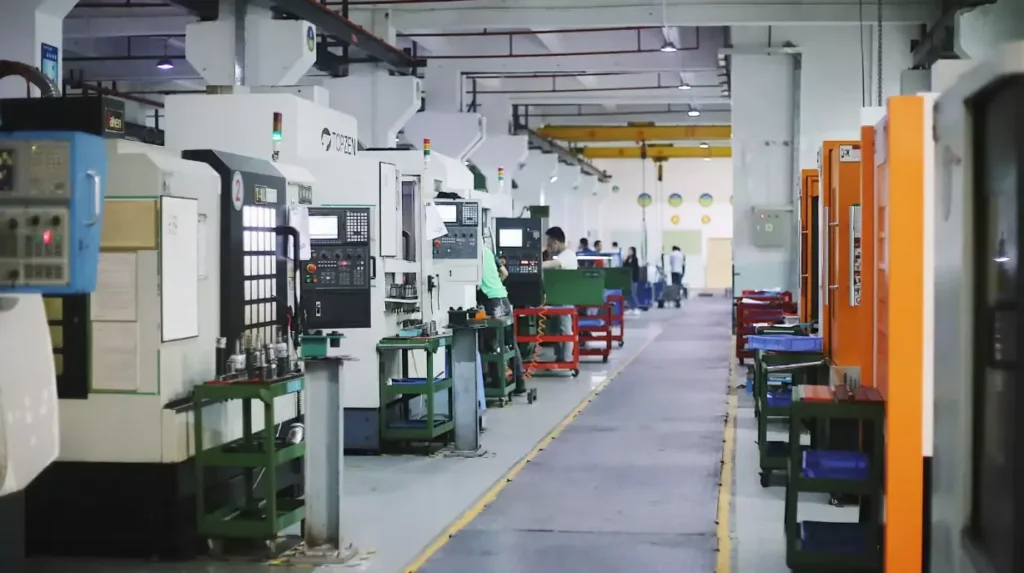
Quality assurance permeates every aspect of the factory’s operations. Coordinate measuring machines (CMMs) with touch probes and laser scanners occupy climate-controlled inspection rooms, verifying part dimensions to micron-level tolerances. In-process inspection stations equipped with optical comparators and surface roughness testers dot the production floor, allowing operators to validate critical features without removing parts from the workflow. The quality management system documents every step of production, from material certifications to final inspection reports, ensuring full traceability for aerospace, medical, and automotive customers. Statistical process control (SPC) software analyzes measurement data in real-time, automatically flagging trends that might indicate tool wear or machine drift before non-conformances occur.
Engineering and programming departments form the technical backbone of the machining factory. CAD/CAM workstations run sophisticated software that converts 3D part models into optimized toolpaths, simulating every cut before releasing programs to the shop floor. Process engineers develop machining strategies that balance cycle time, tool life, and surface finish requirements, often creating custom fixtures for complex components. The factory’s digital thread connects design to production, with revisions flowing seamlessly from customer change requests to updated machine programs. A dedicated R&D area tests new cutting tools, materials, and machining techniques, continuously improving the factory’s capabilities and efficiency.
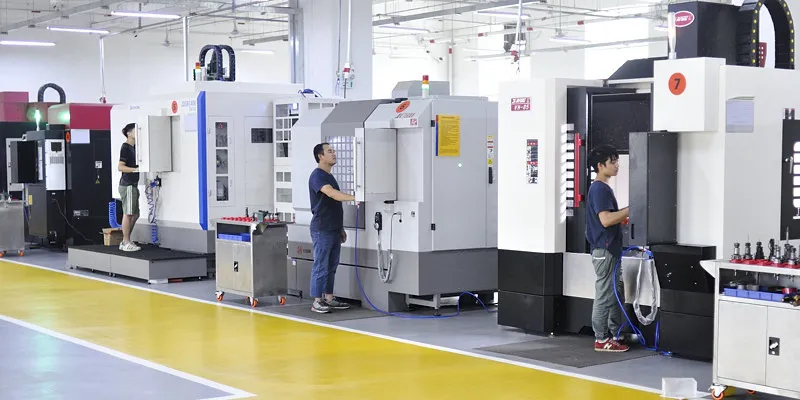
Supporting infrastructure ensures uninterrupted production. A maintenance department stocks critical spare parts – spindle cartridges, ball screws, servo motors – enabling rapid response to equipment issues. Preventative maintenance schedules follow machine hour usage rather than calendar time, with vibration analysis and thermal imaging identifying potential problems before failure occurs. The factory’s power distribution system includes voltage regulators and backup generators, protecting sensitive CNC equipment from power fluctuations. Compressed air systems incorporate redundant compressors and drying equipment, delivering clean, dry air to pneumatic components throughout the facility. Coolant management systems filter, chill, and treat cutting fluids, extending their usable life while maintaining optimal machining conditions.
Workforce organization reflects the factory’s technical complexity. Skilled machinists oversee multiple machines, monitoring cutting sounds and machine diagnostics to maintain quality production. Setup technicians with specialized training perform tool changes and workpiece alignment, often using laser alignment tools and dial indicators to achieve precise machine readiness. Quality technicians move between inspection stations and production cells, validating parts at critical process steps. Engineering staff remain available on the shop floor to troubleshoot programming issues or optimize cutting parameters in real-time. Continuous training programs ensure all personnel stay current with new machine technologies, cutting tool advancements, and quality system requirements.

The factory’s production scheduling system balances hundreds of active jobs across available equipment. Advanced planning software considers machine capabilities, tooling requirements, and material availability when creating the production schedule. RFID tags on work orders and tooling help track progress through the facility, while digital dashboards display real-time machine utilization and job status. For high-mix production, the factory may employ flexible manufacturing systems (FMS) that automatically route palletized workpieces between machines based on current workload. The scheduling system integrates with inventory management, automatically triggering material orders and tool replacement when stock reaches predefined levels.
Customer service and logistics operations complete the factory’s ecosystem. Project managers maintain constant communication with clients, providing updates on order status and addressing technical queries. The shipping department packages finished components according to industry-specific requirements – vacuum-sealed for medical parts, anti-corrosion treated for marine applications, or specially cushioned for delicate aerospace components. Just-in-time delivery systems synchronize production completions with customer needs, while international shipping expertise handles customs documentation for global clients. The factory’s IT infrastructure maintains secure connections with customer PLM systems, enabling direct transfer of design files and automated order processing in some cases.
Environmental and safety systems meet stringent industrial standards. Dust collection systems capture airborne particulates at their source, while oil mist eliminators clean air exhausted from machining enclosures. Waste streams are carefully separated – metal chips go to recycling, used coolant undergoes reclamation, and packaging materials enter appropriate disposal channels. The factory’s safety program includes regular equipment inspections, hazard communication training, and emergency response drills. Machine guarding, lockout/tagout procedures, and personal protective equipment requirements protect workers from the inherent dangers of heavy industrial equipment. Energy efficiency measures like regenerative drives, LED lighting, and heat recovery systems reduce the facility’s environmental footprint while lowering operating costs.
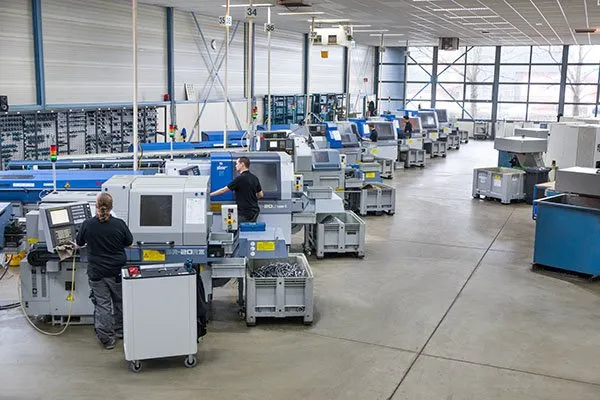
Technological integration continues to transform the modern CNC machining factory. Industrial Internet of Things (IIoT) devices monitor equipment health indicators – spindle vibration, axis servo current, coolant temperature – predicting maintenance needs before they impact production. Digital twin technology creates virtual replicas of physical machining processes, allowing optimization without disrupting live production. Automated guided vehicles (AGVs) increasingly handle material transport between workstations, while collaborative robots assist with repetitive loading/unloading tasks. Cloud-based analytics platforms aggregate data from across the factory, identifying improvement opportunities in tool life management, energy usage, and production flow. These advancements maintain the factory’s competitive edge in an industry where precision, efficiency, and reliability determine success.
The factory’s business systems ensure financial and operational viability. Cost estimation software accurately predicts machining expenses based on material, cycle times, and secondary operations. Quoting teams balance customer pricing expectations with the factory’s technical capabilities and available capacity. Enterprise resource planning (ERP) software tracks every aspect of production from purchase orders to shipment, while customer relationship management (CRM) systems maintain detailed histories of client requirements and preferences. Continuous improvement programs analyze production metrics, identifying opportunities to reduce setup times, improve first-pass yield, or optimize cutting parameters. This data-driven approach allows the factory to maintain profitability while delivering high-quality machined components across diverse industries.

